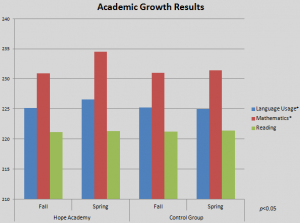Measuring the Impact of Substance Use on Student Academic Achievement
Recovery high schools were created as an alternative option for adolescents after treatment instead of returning to the previous social environment that they came from, however, little research has been conducted on the schools.
Research has shown that adolescents who participated in aftercare showed reduced substance use and substance-related problems 9 months after completing a residential treatment and that a return to the previous social environment can pose a threat to recovery.
Hope Academy, a public charter recovery high school serving 70 students, located on the campus of Fairbanks Hospital in Indianapolis, was the subject of this study. This study was done to look at student achievement before and after matriculation at Hope Academy to see if being in recovery has an impact on academic achievement.
With only 30-40 students enrolled at a time, and as a public charter school, students are accepted from all over the state of Indiana. All students have completed a recovery program recently and the majority of students are white, middle to upper class, and live in the metropolitan area. Many students are referred by the juvenile justice system. Most students are between the ages of 15-18, begun using drugs or alcohol during middle school, and have completed multiple recovery programs.
The study used the Northwest Evaluation Association Measures of Academic Progress (MAP) test, which is designed to measure a student’s academic growth over time. The test is given twice a year and the difference between the scores is a measure of student academic growth. For this study, a matched virtual control group (VCG) was created to provide a comparison group to the students at Hope Academy. To ensure that the groups were similar, the beginning MAP scores for the control group were matched to the scores from Hope Academy.

To measure change in substance use and dependence problems, the Global Appraisal of Individual Needs- Short Screen (GAIN-SS) was administered every 6-8 weeks. The GAIN-SS looks at past month and past year substance use. Data was gathered from 32 students (17 male and 15 female).
When students indicated an increase in substance use over the past year, they did not show any academic growth according to the MAP. However, students who indicated a decrease in the amount of substance use over the past year, revealed a significant increase in student achievement according to the MAP.
While students at Hope Academy did have scores below than the national average, the significant gains in MAP scores strongly suggest the benefit of sobriety on student achievement.
IN CONTEXT
The dual mission of recovery schools to provide an education and support for students in recovery offers a unique opportunity to study the impact that substance use and recovery has on academic growth and student achievement. This study found that students at Hope Academy had significantly higher academic growth compared to the control group and also that as substance use decreases, academic growth increases. This is promising preliminary data in support of recovery high schools.
CITATIONS
Rattermann, M. J. (2014). Measuring the impact of substance abuse on student academic achievement and academic growth. Advances in School Mental Health Promotion, 7(2), 123-135.

